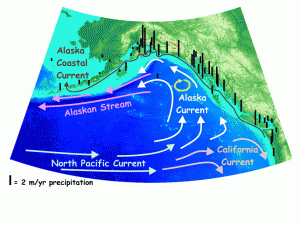- Date: Dec 8th, 10am AST
- Presenter: Rick Edwards, U.S. Forest Service’s North Pacific Research Station in Juneau
- Topic: “Potential impacts of climate change on terrestrial and marine interactions in the coastal temperate rainforest”
Dr. Rick Edwards and colleagues have been researching run-off from the Tongass, current and future changes in snowpack and hydrology due to climate change, and how the seasonality and amount of runoff (as well as nutrients it carries) effects the ecosystem. Edwards’ team has been mostly focused on terrestrial impacts, but are aware of significant influences to the marine system — particularly since freshwater is one of the key drivers of the Alaska coastal current.
What might be the impacts of a larger fluctuation in seasonal outflow? This webinar is an opportunity to add oceanographers, circulation and ecosystem modelers, and other interested people to the conversation. The webinar will provide a chance to learn more about the USGS research, as well as discuss possible implications for the marine system and avenues for research collaboration.
An abstract from Edwards’ project is below. Call-in information will be posted closer to the date. If you are interested in joining, please email Darcy Dugan.
Potential impacts of climate change on terrestrial and marine interactions in the coastal temperate rainforest.
The Coastal Temperate Rainforests (CTR) of the Gulf of Alaska (GOA) are maritime forests closely linked to, and in many cases surrounded by, adjacent estuarine and coastal marine ecosystems. Freshwater runoff from the CTR into the marine ecosystem is huge, of the same order of magnitude as the Columbia River, with total freshwater input from all gulf rivers (including inland rivers) equal to the discharge of the Mississippi River. This runoff contains high concentrations of dissolved organic carbon (DOC) which stimulates food webs in stream and estuarine habitats as it moves to the GOA. Along with DOC, freshwater discharge also contains large masses of nitrogen, phosphorus and micronutrients such as iron, that stimulate production in the freshwater and marine environments receiving them. Runoff from the coastal margin is entrained within massive eddies that transport the chlorophyll and nutrient rich runoff far out into the GOA, stimulating the production of plankton, fish and other consumers hundreds of miles out into the ocean. Although this coupled terrestrial-marine ecosystem supports fisheries worth billions of dollars, little research on the processes that link these ecosystems has been done. Current research on marine-terrestrial material flows has focused on the hypothesis that nutrients in the bodies of salmon returning to spawn fertilize streams and increase productivity of freshwater habitats. However, the flux of carbon, nitrogen and phosphorus from land to sea via stream discharge is 20-100 times greater than the salmon inputs, suggesting that food webs in estuaries and gulf waters are enhanced by terrestrial runoff.
| Carbon (metric tons) | Nitrogen (metric tons) | Phosphorus (metric tons) | |
| Salmon inputs | 7,900 | 1,931 | 281 |
| Terrestrial outputs | 790,000 | 46,078 | 6,200 |
Climate change, with its potential to alter the volume, timing and composition of freshwater runoff to the Gulf, is a major variable in the future health of these coupled ecosystems. Watersheds in the rainforest ecosystem fall into three main hydrologic and biogeochemical classes, with distinct differences in the seasonality and composition of discharge and material flux. These watershed classes differ in the amount of precipitation that is stored as ice and snow through the winter. Differences in the percent of precipitation falling as snow are controlled by watershed morphology and the mean elevation with respect to the rain-snow transition zone elevation. As climate warms and the rain-snow transition zone increases in elevation, less precipitation will be stored as ice and snow and more will run off coincident with rainfall. The seasonal redistribution of freshwater runoff may affect a large percentage of the annual discharge, with unknown impacts on gulf circulation patterns and seasonality of nutrient inputs into estuaries and coastal waters. Through its effect on the snow-rain transition zone, global warming may have significant secondary impacts on the production of stream, estuarine and ocean habitats, with presently unknown impacts on some of the world’s remaining healthy fisheries. Better understanding of the magnitude and importance of reciprocal terrestrial-marine interactions will require improved collaboration among researchers and agencies that presently focus on subcomponents of the broader ecosystem without integrating knowledge across the arbitrary boundaries of discipline and jurisdiction.

